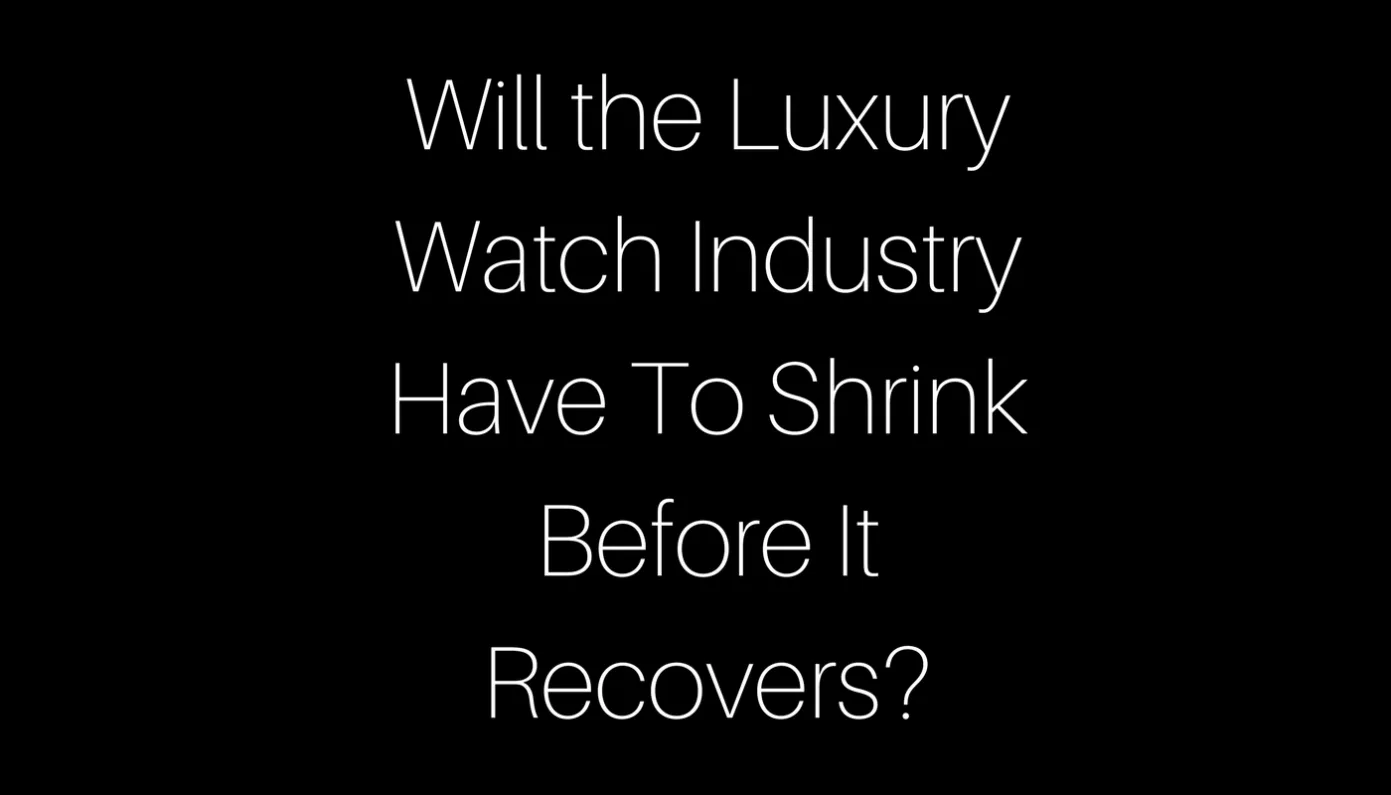By Carl Scutt
This perhaps sounds a little dramatic or at least contradictory but there are some real issues in the market and a real argument for market shrinkage before a recovery. Before I get into it properly, maybe I need to clarify what the Luxury Watch Market is in this scenario? If we put aside the affordable entry level luxury and the grey market to concentrate on the genuine luxury Swiss brands with high price points, we’re on point.
The top brands have been here before or at least in crisis before, with what was known as the quartz crisis of the 1970’s when the cheaper, more accurate quartz movements flooded the market. And again we see the industry bashed bruised by a number of issues from the global financial meltdown from 2008, the global effect of terrorism throughout Europe and the fall in consumer confidence in China, one of the major luxury watch markets.
The New Challenge

It’s been 40 years since the quartz crisis and coming up to 8 years since the global depression and the Luxury watch industry is facing yet a crisis, described by some as ‘disruptive technology‘. While this may be an extreme view, the introduction of better, faster, cheaper, and now high technology augmented watches, the Swiss mechanical movements can never realistically compete in terms of features, accuracy or price.
This paradoxically remains part of the problem and part of the solution while cheap reliable and accurate timepieces are built in large quantities, forcing the luxury Swiss market to follow suit due to modern business practices.
An Industry Glut
As we all know the majority of well known watch brands are owned by large conglomerates Swatch Group, Richemont, LVMH, and Kering for example, making them all subject to corporate structure and strategy, which in short, means over production to meet board or shareholder demands for ever greater profits.

Although this comes hand in hand with more educated and knowledgeable clientele with an interest in quality pieces, this doesn’t equate to a blind need to spend big. On the contrary, the big spenders are well aware of the new market power they have at their disposal. Just take it as read, everyone looking to drop $10,000 of a nice Swiss piece, knows there’s somewhere else to pick up the same piece for substantially less.
Essentially, the bricks and mortar outlets with stricter financial and stock restrictions only have the customer service to back up their sales. But these days even the ‘Watch Whales’ aren’t necessary persuaded by a fawning shop assistant with a broad smile and glass of Champagne.
The Times They Are A Changin
The internet of things is with us, our fridges can order milk, our phones do everything but very rarely make voice calls, and watches are now always connected with Bluetooth and GPS as well as solar powered. It’s only natural the Internet would take up the slack where corporate greed, overproduction, and high prices have created an environment that not only damages brand values, but also threatens the brands should they attempt to crush the monster they’ve created. I am speaking of course, of the grey market. Basically, growth is the converse of exclusivity, but the corporate mindset has created a secondary market at the expense of their exclusivity.
Brand Value Dilution
The brands have been notorious in the past for keeping a tight grip on the reins in order to hold their brand values, by nailing down their authorized dealers with tight regulation, but the oversupply, coupled with the drop in overall demand has had something of an unexpected effect on the market. The oversupply that can damage brand value has inevitably found its way into the grey, the unregulated market that brands previously were so eagerly to avoid, but now, have to finally admit reliance on in this diluted marketplace.

Surely it’s not bad news all round, where luxury pieces can be acquired for an affordable price everyone’s happy, right? It may not be so cut and dry when we consider the human cost in an industry where morale is at an all-time low and employment has been stripped to the bare bones.
So, let’s just take a look at what we have.
Firstly, luxury brands selling less through their authorized dealers who maintain brand value through price protection and high-level customer services. Secondly, more pieces being produced under a corporate strategy to keep shareholders and boards happy, and thirdly, the oversupply of pieces has inevitably seen the excess find its way onto the online discount stores or grey market, which all adds up to an erosion of brand value.
What’s The Answer?
As a watch enthusiast and blogger, my interest is in both high-quality luxury with affordability. That can come in a couple of flavors, the first being ‘entry level’ luxury from the big brands, and the grey market which can be argued, is killing the luxury market. At this point, however, I’d like to point out that the grey market would not exist if the overproduction was stopped and the brands were serious about only supplying their authorized dealers.

The most exciting option we see is the modern era is the appearance of the small independent manufactures that are small and lean enough to produce top quality products at genuinely low prices due to their business model’ of being online-only manufacturers. I am speaking of such delights as Christopher Ward and Bremont who both design and build their very own cases and movements, yet still remain as affordable as an entry level Swiss pieces made possible by Swiss/British partnerships.
The Final Word
So, does the Luxury Swiss watch industry need to shrink before it can recover? Well, the evidence suggests the overproduction is eroding the brand value which in turn erodes confidence in prices and value of the product line.
If that is to be reversed, the corporate mentality will need to change substantially to limit production together with only supplying authorized dealer, which in short, will destroy the grey market to elevate the brand values to their previous positions. If the industry is serious about turning this particular clock back they’ll need to give up the relatively large numbers of grey market sales that have helped sustain them through this dark period, throttle back production and hope brand value can drive demand.
After having access to the grey market for such a long time, and the heightened education of the watch buying public, together with the availability of luxury Japanese watches, and the small British/Swiss partnerships such as Christopher Ward and Bremont, whatever the luxury manufacturers do, it could well be a painful process and they should be prepared for anything.



